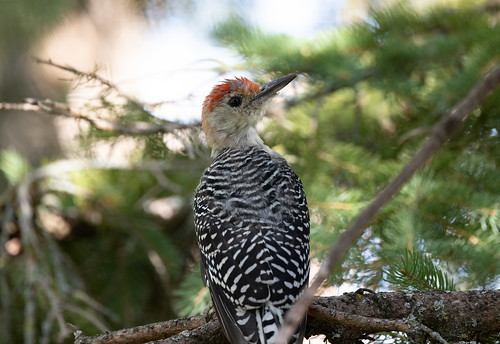On January 31 of this year, my husband Russ set a small platform feeder on the window outside my new home office. I’d switched last year from the largest room in the house to one of the smallest when my daughter and son-in-law came to live with us. I didn’t mind losing the space—I'm close to retiring so was ready to downsize my stuff anyway, and my new office is nice and cozy. But I was sad about losing my two large windows, one facing the backyard, the other looking into the branches of one of my box elders. As it turns out, the much smaller single window I have in my new space has given me some of the nicest photos I’ve ever taken, and the feeder Russ put in has increased the photo ops enormously.
The first birds to show up at the feeder were, of course, chickadees, but I cheated—all I had to do was whistle to get them to fly in for mealworms. Red- and White-breasted Nuthatches and a Downy Woodpecker keeping track of the chickadees also quickly found the feeder.
All was well until February 4 when a gray squirrel jumped into it from an overhang about 2 feet lower than the feeder and about four feet away horizontally, an especially tricky maneuver when the overhang was slippery with ice. But that was the only time I saw a squirrel in the feeder for a few months. By the end of April, my feeder bird list was up to 13 species.
But with spring, a couple of squirrels became adept at the long jump. It was irritating, but not enough for me to close down the feeder until spring migration was over. The squirrels were a small price to pay for some lovely Indigo Bunting photos.
When I closed down the feeder at the start of June, my nesting chickadees could still catch my eye and I’d open the window to give them mealworms. But the window feeder was otherwise left empty all summer. The few times I filled it this fall, a squirrel showed up within an hour.
But with this year’s amazing Blue Jay migration, I really really wanted to get the window feeder going again. Neither Russ nor I could think of a single way to close off access to those squirrels. So I finally decided to try some birdseed laced with hot red peppers.
I used to counsel caution regarding bird food formulations with peppers. It seemed like anything that could burn our mouths and be such an irritant to our eyes had to be equally bad for birds even if they lacked the taste receptors to shun it. But I recently read about the evolution of peppers. Squirrels and other mammals chew fruits, breaking and grinding up the seeds, which damages rather than helps a plant’s chances of reproduction. Birds swallow chunks of fruits whole, so most of the seeds remain intact as they pass through the avian digestive system, and birds fly to many places over the course of a day, allowing them to “plant” those seeds over a large area. The bright colors of peppers evolved specifically to attract birds, and the pepper fruits are very nutritious, keeping birds coming back. So on September 11, I bought an expensive bag of what Wild Birds Unlimited calls “Fiery Feast” and put it in the feeder.
Chickadees were first to come, grab peanut halves, and fly off, but Blue Jays weren’t far behind. My feeder is just 22” x 9”, and it’s hard for birds to sit along the edge against the windowsill, but I’ve had as many as 12 jays crowd in to pig out. We still have a big platform feeder and a small one, both filled with regular sunflower seeds, down in the regular, squirrel-proof feeding station, and every day all week jays have been crowding into all of them as well as visiting the birdbaths and spending time in the trees. I live right under Hawk Ridge where, as of the end of the day yesterday, September 19, they’d counted 48,523 jays, and apparently a lot of them want a lunch break as they pass over.
A squirrel jumped in two or three times that first day, and once or twice since then, but one taste and it jumped right back out.
Blue Jays and chickadees haven’t been the only birds to visit the feeder. So far no other songbirds have stopped at it, probably because they don’t want to contend with the jays, but I’ve had both an adult female and a young male Red-bellied Woodpecker coming a few times each day.
If that wasn’t good enough, one female flicker showed up this weekend, giving me several fairly good photos right through the window glass—I have always seen plenty of flickers in my yard, including at my birdbaths, but this is the first one in all our years on Peabody Street to visit any of our bird feeders. So that was of course very cool.
Even better, I’ve had at least two Pileated Woodpeckers—a male and a female—coming to the feeder.
Both pileateds and flickers are also attracted to ants, which are laced with formic acid, but I didn’t expect either to show up for seeds laced with hot peppers. I love how after birding for 46 years, I’m still learning.
In another week or so, I’ll start mixing in more affordable fare, keeping enough of the peppery food in there to remind the squirrels to stay clear. “Fiery Feast” is expensive and the birds eating it have big appetites—they went through a $36 bag in just one week. That’s a pretty steep price to pay to keep one feeder squirrel-free, but again, after birding for 46 years, I apparently still have a lot to learn.








